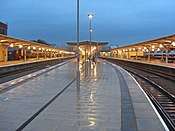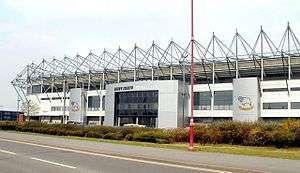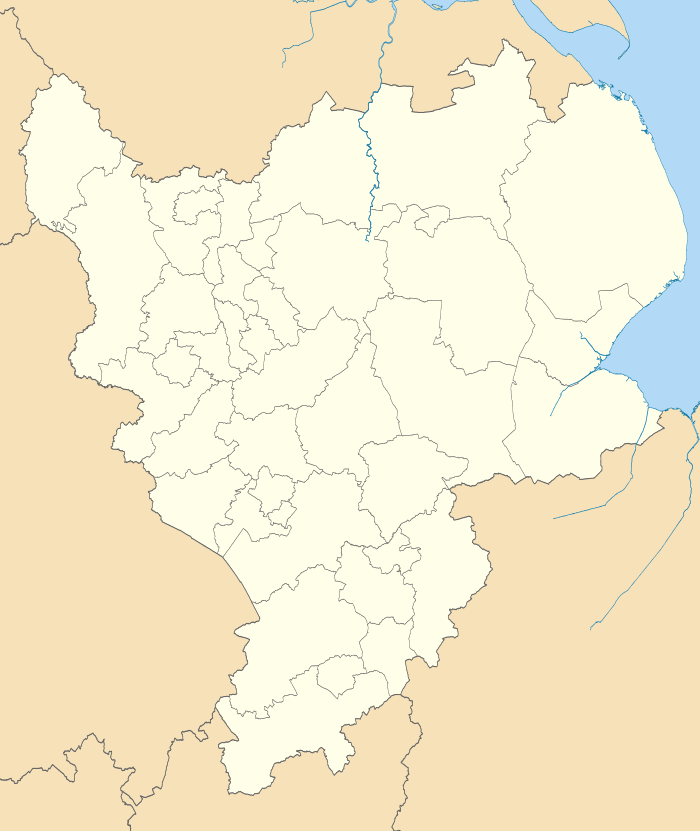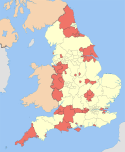Derby
Derby (/ˈdɑːrbi/ (![]()
Derby | |
|---|---|
| City of Derby | |
| Motto(s): "Industria, Virtus, et Fortitudo" | |
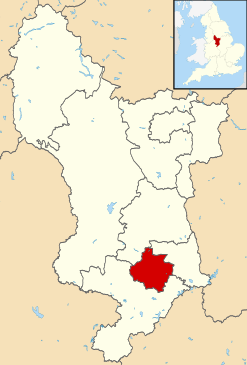 Shown within Derbyshire | |
 Derby Location within England  Derby Location within the United Kingdom  Derby Location within Europe | |
| Coordinates: 52°55′N 1°28′W | |
| Sovereign state | United Kingdom |
| Country | England |
| Region | East Midlands |
| Ceremonial county | Derbyshire |
| Admin HQ | Derby |
| Settled | AD 600 |
| City Status | 1977 |
| Government | |
| • Type | Unitary authority, City |
| • Governing body | Derby City Council |
| • Leadership | Leader and Cabinet |
| • Executive | Conservative (council NOC) |
| • MPs | |
| Area | |
| • City and Unitary authority area | 30.13 sq mi (78.03 km2) |
| Population (2011 Census) | |
| • City and Unitary authority area | 248,700 |
| • Density | 7,840/sq mi (3,028/km2) |
| • Urban | 270,500 |
| • Metro | 1,543,000 (Nottingham-Derby)[1] |
| • Ethnicity (Office for National Statistics 2011 Census)[2] |
|
| Time zone | UTC+0 (Greenwich Mean Time) |
| Postcode span | |
| Area code(s) | 01332 |
| Twin/sister towns | Country |
| Germany (since 1976) | |
| Toyota, Japan | Japan |
| Grid Ref. | SK3533936187 |
| ONS code |
|
| ISO 3166-2 | GB-DER |
| NUTS 3 | UKF11 |
| Demonym | Derbeian |
| Website | derby |
Derby was settled by Romans – who established the town of Derventio – Saxons and Vikings, who made Derby one of the Five Boroughs of the Danelaw. Initially a market town, Derby grew rapidly in the industrial era. Home to Lombe's Mill, an early British factory, Derby has a claim to be one of the birthplaces of the Industrial Revolution. It contains the southern part of the Derwent Valley Mills World Heritage Site. With the arrival of the railways in the 19th century, Derby became a centre of the British rail industry.
Derby is a centre for advanced transport manufacturing, being home to the world's second largest aero-engine manufacturer: Rolls-Royce. Bombardier Transportation are based at the Derby Litchurch Lane Works and were for many years the UK's only train manufacturers. Toyota Manufacturing UK's automobile headquarters is southwest of the city at Burnaston. To the east lies Nottingham, separated by the M1 motorway.
History
Origins
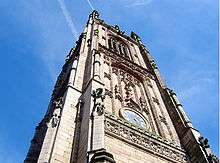

The Roman camp of 'Derventio' is considered to have been at Little Chester/Chester Green (grid reference SK353375), the site of the old Roman fort. Later the town was one of the 'Five Boroughs' (fortified towns) of the Danelaw, until it was captured by Lady Aethelflaed of Mercia in July 917, after which the town was annexed to the Kingdom of Mercia.[4]
The Viking name Djúra-bý, recorded in Old English as Deoraby, means "village of the deer". However, the origin of the name Derby has had multiple influences: a variation of the original Roman name Derventio with pronunciation of the letter 'v' as 'b', becoming Derbentio, and later Derby, along with a link to the river Derwent – from the Celtic meaning "valley thick with oaks"[5] – which flows through the city, triggering a shortened version of Derwent by, meaning 'Derwent settlement'.
The town name appears as Darbye on early maps, such as that of John Speed, 1610.[6]
Modern research (2004) into the history and archaeology of Derby has provided evidence that the Vikings and Anglo-Saxons would have co-existed, occupying two areas of land surrounded by water. The Anglo-Saxon Chronicle (c. 900) says that "Derby is divided by water". These areas of land were known as Norþworþig ("Northworthy" = "north enclosure") and Deoraby, and were at the "Irongate" (north) side of Derby.[7]
16th–18th centuries
During the Civil War of 1642–1646, Derby was garrisoned by Parliamentary troops commanded by Sir John Gell, 1st Baronet, who was appointed Governor of Derby in 1643. These troops took part in the defence of nearby Nottingham, the Siege of Lichfield, the Battle of Hopton Heath and many other engagements in Nottinghamshire, Staffordshire and Cheshire, as well as successfully defending Derbyshire against Royalist armies.
A hundred years later, Bonnie Prince Charlie set up camp at Derby on 4 December 1745, whilst on his way south to seize the British crown. The prince called at The George Inn on Irongate, where the Duke of Devonshire had set up his headquarters, and demanded billets for his 9,000 troops.

He stayed at Exeter House, Full Street, where he held a "council of war". A replica of the room is on display at Derby Museum in the city centre. He had received misleading information about an army coming to meet him south of Derby. Although he wished to continue with his quest, he was over-ruled by his fellow officers. He abandoned his invasion at Swarkestone Bridge on the River Trent just a few miles south of Derby. As a testament to his belief in his cause, the prince – who on the march from Scotland had walked at the front of the column – made the return journey on horseback at the rear of the bedraggled and tired army.
Industrial Revolution
Derby and Derbyshire were among the centres of Britain's Industrial Revolution. In 1717, Derby was the site of the first water-powered silk mill in Britain, built by John Lombe and George Sorocold, after Lombe had reputedly stolen the secrets of silk-throwing from Piedmont in Italy (he is alleged to have been poisoned by the Piedmontese as revenge in 1722).
In 1759, Jedediah Strutt patented and built a machine called the Derby Rib Attachment[8] that revolutionised the manufacture of hose. This attachment was used on the Rev. Lee's Framework Knitting Machine; it was placed in front of – and worked in unison with – Lee's Frame, to produce ribbed hose (stockings). The partners were Jedediah Strutt, William Woollatt (who had been joined in 1758 by John Bloodworth and Thomas Stafford, all leading hosiers in Derby). The patent was obtained in January 1759. After three years, Bloodworth and Stafford were paid off, and Samuel Need – a hosier of Nottingham – joined the partnership. The firm was known as Need, Strutt and Woollatt. The patent expired in 1773[8] though the partnership continued until 1781 when Need died.
| Year | Pop. | ±% |
|---|---|---|
| 1801 | 14,695 | — |
| 1851 | 48,506 | +230.1% |
| 1901 | 118,469 | +144.2% |
| 1921 | 142,824 | +20.6% |
| 1941 | 167,321 | +17.2% |
| 1951 | 181,423 | +8.4% |
| 1961 | 199,578 | +10.0% |
| 1971 | 219,558 | +10.0% |
| 1981 | 214,424 | −2.3% |
| 1991 | 225,296 | +5.1% |
| 2001 | 221,716 | −1.6% |
| 2011 | 248,700 | +12.2% |
| [9] | ||
Messrs Wright, the bankers of Nottingham, recommended that Richard Arkwright apply to Strutt and Need for finance for his cotton spinning mill. The first mill opened in Nottingham in 1770 and was driven by horses. In 1771 Richard Arkwright, Samuel Need and Jedediah Strutt built the world's first commercially successful water-powered cotton spinning mill at Cromford, Derbyshire, developing a form of power that was to be a catalyst for the Industrial Revolution.[10][11][12]
This was followed in Derbyshire by Jedediah Strutt's cotton spinning mills at Belper. They were: South Mill, the first, 1775; North Mill, 1784, which was destroyed by fire on 12 January 1803 and then rebuilt, starting work again at the end of 1804; West Mill, 1792, commenced working 1796; Reeling Mill, 1897; Round Mill, which took 10 years to build, from 1803 to 1813, and commenced working in 1816; and Milford Mills, 1778. The Belper and Milford mills were not built in partnership with Arkwright; they were all owned and financed by Strutt.
Other notable 18th-century figures with connections to Derby include the painter Joseph Wright, known as Wright of Derby, who was known for his innovative use of light in his paintings and was an associate of the Royal Academy; and John Whitehurst, a clockmaker and philosopher. Erasmus Darwin, doctor, scientist, philosopher and grandfather of Charles Darwin, whose practice was based in Lichfield, Staffordshire, was a frequent visitor to Derby, having founded the Derby Philosophical Society.
Derby's place in the country's philosophical and political life continued with Henry Hutchinson, an active member of the Fabian Society. On his death in 1894, he left the society an amount in his will which was instrumental in founding the London School of Economics.[13]
The beginning of 19th century saw Derby emerging as an engineering centre, with manufacturers such as James Fox, who exported machine tools to Russia.
In 1840, the North Midland Railway set up its works in Derby and when it merged with the Midland Counties Railway and the Birmingham and Derby Junction Railway to form the Midland Railway, Derby became its headquarters. The connection with the railway encouraged others, notably Andrew Handyside, Charles Fox and his son Francis Fox.
A permanent military presence was established in the city with the completion of Normanton Barracks in 1877.[14]
Derby was one of the boroughs reformed by the Municipal Corporations Act 1835, and it became a county borough with the Local Government Act 1888. The borough expanded in 1877 to include Little Chester and Litchurch, and then in 1890 to include New Normanton and Rowditch. The borough did not increase substantially again until 1968, when under a recommendation of the Local Government Boundary Commission it was expanded into large parts of the rural district of Belper, Repton and South East Derbyshire. This vastly increased Derby's population from 132,408 in the 1961 census to 219,578 in the 1971 census.[15]
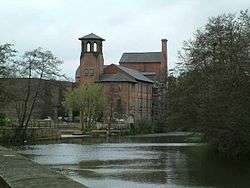
Despite being one of the areas of Britain furthest from the sea, Derby holds a special place in the history of marine safety – it was as MP for Derby that Samuel Plimsoll introduced his bills for a 'Plimsoll line' (and other marine safety measures). This failed on first introduction, but was successful in 1876 and contributed to Plimsoll's re-election as an MP.
20th century to present day
An industrial boom began in Derby when Rolls-Royce opened a car and aircraft factory in the town in 1907. In 1923, the Midland Railway became part of the London, Midland and Scottish Railway with headquarters in London. However, Derby remained a major rail manufacturing centre, second only to Crewe and Wolverton. Moreover, it remained a design and development centre and in the 1930s, on the direction of Lord Stamp, the LMS Scientific Research Laboratory was opened on London Road.
In 1911 the Derby Wireless Club was formed by a group of local engineers and experimenters. It was to be the first radio or 'wireless club' in the country.[16][17]
In World War I, Derby was targeted by German Zeppelin air bombers, who killed five people in a 1916 raid on the town.[18]
All Saints Church was designated as a cathedral in 1927, signalling that the town was ready for city status.[19]
Slum clearance in the 1920s and 1930s saw the central area of Derby become less heavily populated as families were rehoused on new council estates in the suburbs, where houses for private sale were also constructed. Rehousing, council house building and private housing developments continued on a large scale for some 30 years after the end of World War II in 1945.[20]
Production and repair work continued at the railway works. In December 1947 the Locomotive Works unveiled Britain's first mainline passenger diesel-electric locomotive – "Number 10000". In 1958 production switched over to diesel locomotives completely. Meanwhile, the Carriage & Wagon Works were building the first of the Diesel Multiple Units that were to take over many of the services.
In 1964 the British Rail Research Division opened to study all aspects of railway engineering from first principles. Its first success was in drastically improving the reliability and speed of goods trains, work which led to the development of the Advanced Passenger Train.
Derby was awarded city status on 7 June 1977 by Queen Elizabeth II to mark the 25th anniversary of her ascension to the throne.[21] The Queen presented the "charter scroll" or 'letters patent' in person on 28 July 1977 on the steps of the Council House to the then Mayor Councillor Jeffrey Tillet (Conservative).[22] Until then, Derby had been one of the few towns in England with a cathedral but not city status.
Derby holds an important position in the history of the Labour movement as one of two seats (the other being Keir Hardie's in Merthyr Tydfil) gained by the recently formed Labour Representation Committee at the 1900 general election. The MP was Richard Bell, General Secretary of the Railway Servants Union. Bell was succeeded in 1910 by Jimmy Thomas and he in turn by the distinguished polymath and Nobel Laureate Philip Noel-Baker in 1936.
Despite its strategic industries (rail and aero-engine), Derby suffered comparatively little damage in both world wars (contrast Bristol and Filton). This may in part have been due to the jamming against the German radio-beam navigations systems (X-Verfahren and Knickebein, camouflage and decoy techniques ('Starfish sites') were built, mainly south of the town, e.g. out in fields near Foremark.[23][24])
Derby has also become a significant cultural centre for the deaf community in Britain. Many deaf people move to Derby because of its strong sign language-using community. It is estimated that the deaf population in Derby is at least three times higher than the national average, and that only London has a larger deaf population. The Royal School for the Deaf on Ashbourne Road provides education in British Sign Language and English.
Government
Local government
By traditional definitions, Derby is the county town of Derbyshire, although Derbyshire's administrative centre has in recent years been Matlock. On 1 April 1997, Derby City Council became again a unitary authority (a status it had held, as a county borough, up until 1974), having previously been administered from Matlock along with the rest of Derbyshire. On 7 July 2014, Derby's first ever Youth Mayor, Belal Butt (a student from Chellaston Academy), was elected by the Mayor of Derby.[25]
Derby is divided into seventeen electoral wards, each of which elects three members of Derby City Council.[26]
| Ward | Areas within the ward |
|---|---|
| Abbey | Stockbrook and Normanton (part of) |
| Allestree | Allestree and Markeaton Park |
| Alvaston | Alvaston, Crewton, Litchurch, Pride Park, Wilmorton and Allenton (part of) |
| Arboretum | City Centre, Pear Tree and Rose Hill |
| Blagreaves | Sunny Hill and Littleover (part of) |
| Boulton | Boulton and Allenton (part of) |
| Chaddesden | Chaddesden (older part of) |
| Chellaston | Chellaston and Shelton Lock |
| Darley | Darley Abbey, Five Lamps, Little Chester (also known as Chester Green), Strutt's Park, Six Streets and West End |
| Derwent | Breadsall Hilltop and Chaddesden (newer part of) |
| Littleover | Littleover (most of) and Heatherton Village |
| Mackworth | Mackworth and Morley Estate |
| Mickleover | Mickleover |
| Normanton | Normanton (most of) and Austin Estate |
| Oakwood | Oakwood and Chaddesden (part of) |
| Sinfin | Sinfin, Osmaston and Stenson Fields (part of) |
| Spondon | Spondon |
UK parliament
Derby was a single United Kingdom Parliamentary constituency represented by two members of parliament until 1950, when it was divided into the single-member constituencies of Derby North and Derby South. However, in 2010, the wards of Allestree, Oakwood and Spondon were moved to the new constituency of Mid Derbyshire, created for the 2010 general election. As of 2020, Derby is represented by three MPs.
| Derby North | Derby South | Mid Derbyshire |
|---|---|---|
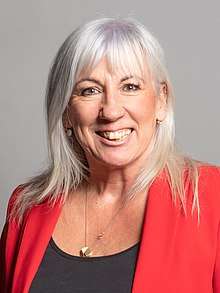 |
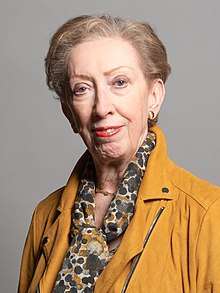 |
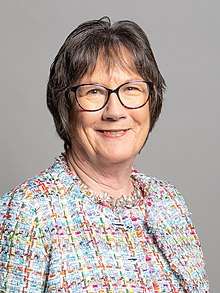 |
| Amanda Solloway | Margaret Beckett | Pauline Latham |
| Conservative | Labour | Conservative |
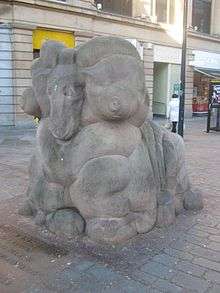
City emblem
Derby's emblem is the Derby Ram, about which there is a folk song titled "The Derby Ram". It is found in a number of places, most notably serving as the nickname of Derby County F.C.. The logo of the City Council's services is a stylised ram.
Geography
Derby is in a relatively low-lying area along the lower valley of the River Derwent, between the lowlands and valley of the River Trent to the south, and the south-east foothills of the Pennines to the north.[27] The city is bordered by four national character areas, the Trent Valley Washlands to the south, the Nottinghamshire, Derbyshire and Yorkshire Coalfields in the east, the South Derbyshire Claylands in the west, and the Derbyshire Peak Fringe in the north. Most of the flat plains surrounding Derby lie in the Trent Valley Washlands and South Derbyshire Claylands, while the hillier, northern parts of the city lie within the Derbyshire Peak Fringe and the Coalfields.[28]
Derby urban area
The Office of National Statistics has defined an urban area for Derby consisting of the city itself plus suburbs and villages in surrounding districts.
Green belt
Derby has a green belt area defined to the north and east of the city, first drawn up in the 1950s, to prevent convergence with the surrounding towns and villages. It extends for several miles into the counties of Derbyshire and Nottinghamshire, covering much of the area up to Nottingham.
Climate
Derby's climate is classified as warm and temperate. The rainfall in Derby is significant, with precipitation even during the driest month. This location is classified as Cfb according to the Köppen climate classification. Under the Köppen climatic classification, Derby, in spite of its distance from large bodies of water, has an oceanic climate along with the rest of the British Isles. The average annual temperature is 9.7 °C in Derby. Precipitation here averages 694 mm.[29]
| Climate data for Derby | |||||||||||||
|---|---|---|---|---|---|---|---|---|---|---|---|---|---|
| Month | Jan | Feb | Mar | Apr | May | Jun | Jul | Aug | Sep | Oct | Nov | Dec | Year |
| Average high °C (°F) | 6.0 (42.8) |
6.7 (44.1) |
9.7 (49.5) |
12.6 (54.7) |
16.4 (61.5) |
19.7 (67.5) |
21.3 (70.3) |
20.7 (69.3) |
18.0 (64.4) |
14.0 (57.2) |
9.3 (48.7) |
7.1 (44.8) |
13.5 (56.2) |
| Daily mean °C (°F) | 3.2 (37.8) |
3.8 (38.8) |
6.1 (43.0) |
8.6 (47.5) |
12.0 (53.6) |
15.1 (59.2) |
16.8 (62.2) |
16.2 (61.2) |
13.8 (56.8) |
10.4 (50.7) |
6.3 (43.3) |
4.3 (39.7) |
9.7 (49.5) |
| Average low °C (°F) | 0.5 (32.9) |
0.9 (33.6) |
2.6 (36.7) |
4.6 (40.3) |
7.6 (45.7) |
10.6 (51.1) |
12.4 (54.3) |
11.8 (53.2) |
9.7 (49.5) |
6.8 (44.2) |
3.4 (38.1) |
1.6 (34.9) |
6.0 (42.9) |
| Average precipitation mm (inches) | 62 (2.4) |
49 (1.9) |
53 (2.1) |
51 (2.0) |
55 (2.2) |
58 (2.3) |
55 (2.2) |
64 (2.5) |
59 (2.3) |
58 (2.3) |
63 (2.5) |
67 (2.6) |
694 (27.3) |
| Source: [30] | |||||||||||||
Nearby settlements
Industry
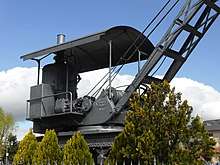
Derby's two biggest employers,[31] Rolls-Royce Holdings and Toyota, are engaged in engineering manufacturing. Other companies of note include railway systems engineering firm Bombardier Transportation, who manufacture railway rolling stock at Derby Litchurch Lane Works; First Source, who deal with much of Sky's telephone support; and Alstom, who manufacture large power plant boilers and heat exchangers.
Derby power station on Silk Mill Lane supplied electricity to the town and the surrounding area from 1893 until its closure in 1969.[32]
From 1922 Sinfin Lane was the home of the 62-acre (250,000 m2) site of International Combustion, originally manufacturers of machinery for the automatic delivery of pulverised fuel to furnaces and boilers, and later producing steam-generating boilers for use in electrical generating plant such as used in power stations. In the 1990s the firm was bought by Rolls-Royce plc and then sold on again to ABB Group.[33]
Derby was the home of Core Design (originally based on Ashbourne Road), who developed the successful video game Tomb Raider. When Derby's inner ring road was completed in 2010, a section of it was named 'Lara Croft Way' after the game's heroine Lara Croft.
One of Derby's longest-established businesses is Royal Crown Derby, which has been producing porcelain since the 1750s.
The Midlands Co-operative Society, a predecessor of Central England Co-operative, traced its origins to Derby Co-operative Provident Society which, in 1854, was one of the first co-operatives in the region.
Infinity Park Derby is a planned business park for aerospace, rail and automotive technology adjacent to the Rolls-Royce site in Sinfin. In December 2014, the government announced that the park would gain enterprise zone status by being added to Nottingham Enterprise Zone.[34]
Railway engineering
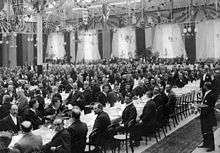
As a consequence of the Midland Railway having their headquarters in Derby, along with their Locomotive and Carriage & Wagon Works, the railways had been a major influence on the development of the town during the Victorian period.
However, during the 20th century, railway manufacturing developed elsewhere, while in Derby the emphasis shifted to other industries. Even though it had pioneered the introduction of diesel locomotives, new production finished in 1966. Repair work gradually diminished until the locomotive works closed, the land being redeveloped as Pride Park. The only buildings remaining are those visible from Platform 6 of the station.
The Carriage and Wagon Works continues to build trains under Bombardier Transportation. The Railway Technical Centre continues to house railway businesses, including the headquarters of DeltaRail Group, formerly the British Rail Research Division.
Derby railway station retains an important position in the railway network. East Midlands Railway operate Derby Etches Park depot while Network Rail and Rail Operations Group also maintain trains in Derby. The city is favoured as a site for a national railway centre.[35]
Derby is also the headquarters of the Derby Railway Engineering Society, founded in 1908 to promote railway engineering expertise both in the city and nationally.
Landmarks
Derby Cathedral tower is 212 feet (65 metres) tall to the tip of the pinnacles. This has been home to a pair of breeding peregrine falcons since 2006,[36] monitored by four webcams.[37]
Derby Gaol is a visitor attraction based in the dungeons of the Derbyshire County Gaol, which dates back to 1756.
Derby Industrial Museum is housed in Derby Silk Mill and shows the industrial heritage and technological achievement of Derby, including Rolls-Royce aero engines, railways, mining, quarrying and foundries. The Silk Mill stands at the southern end of the 24 km (15 mi) stretch of the River Derwent designated a World Heritage Site in 2001.
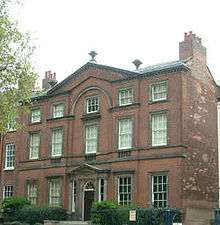
Pickford's House Museum was built by architect Joseph Pickford in 1770. It was his home and business headquarters. Derby Museum and Art Gallery shows paintings by Joseph Wright, as well as fine Royal Crown Derby porcelain, natural history, local regiments and archaeology. Pickford also designed St Helen's House in King Street.
The skyline of the inner city changed in 1968 when the inner ring road with its two new crossings of the River Derwent was built. The route of the ring road went through the St Alkmund's Church and its Georgian churchyard, the only Georgian square in Derby. Both were demolished to make way for the road, a move still criticised today. Thus the editor (Elizabeth Williamson) of the 2nd edition of Pevsner for Derbyshire wrote: "...the character and cohesion of the centre has been completely altered by the replacement of a large number of C18 houses in the centre by a multi-lane road. As a traffic scheme this road is said to be a triumph; as townscape it is a disaster."
Places of interest
- Cathedral Quarter
- Darley Abbey
- Derby Arboretum
- Derby Canal
- Derby Cathedral
- Derby Museum and Art Gallery
- Derby Industrial Museum (Silk Mill)
- St Mary's Church, Derby
- Derby Friargate Station (of which all that remains is Handyside's bridge and the bridge across Friargate)
- Pride Park Stadium (Derby County F.C.) and its predecessor the Baseball Ground (now demolished)
- River Derwent
- St Helen's House, Derby
- Derby Catacombs
- Intu shopping centre
- Saint Benedict Catholic School and Performing Arts College secondary school
- Royal Crown Derby Museum and Factory Tour
- Pickford's House Museum
- Derby Arena
Transport
Roads
The city has extensive transport links with other areas of the country. The M1 motorway passes about ten miles (16 km) east of the city, linking Derby southwards to the London area and northwards to Sheffield and Leeds. Other major roads passing through or near Derby include the A6 (historically the main route from London to Carlisle, also linking to Leicester and Manchester), A38 (Bodmin to Mansfield via Bristol and Birmingham), A50 (Warrington to Leicester via Stoke-on-Trent), A52 (Newcastle-under-Lyme to Mablethorpe, including Brian Clough Way linking Derby to Nottingham) and A61 (Derby to Thirsk via Sheffield and Leeds).
On 16 March 2011, Mercian Way, the final section of the city's inner ring road, was opened to traffic.[38] This new section connects Burton Road with Uttoxeter New Road, and crosses Abbey Street. Abbey Street is the only road between the two ends from which Mercian Way can be accessed.
Railways
Derby station is operated by East Midlands Railway and is served by express services to London, the North East and South West, provided by East Midlands and CrossCountry. There also remain local stations at Peartree and Spondon, although services are limited, especially at the former.
Air
East Midlands Airport is about fifteen miles (24 km) from Derby city centre. Its proximity to Derby, the fact that the airport is in Leicestershire, and the traditional rivalry between the three cities (Derby, Leicester and Nottingham), meant that there was controversy concerning the airport's decision to prefix its name with Nottingham in 2004. In 2006, Nottingham East Midlands Airport reverted to its previous name. The airport is served by budget airlines, including Ryanair and Jet2, with services to domestic and European destinations.
Derby Airfield, approximately 7 miles (11 km) southwest of the city centre, has grass runways targeted at general aviation.
Bus and coach
The Derby bus station has 29 bays, 5 for coaches and 24 for general bus services. Local bus services in and around Derby are run by a number of companies, but principally Trent Barton and Arriva Midlands. The city is on National Express' London to Manchester and Yorkshire to the South West routes.
Culture, entertainment and sport
Music
In rock music, the blues singer-songwriter Kevin Coyne came from Derby, as does the three-piece rock band LostAlone, and indie/glam rock band The Struts. The ska punk band Lightyear also hail from the city, naming their second album Chris Gentlemens Hairdresser and Railway Book Shop after a shop in Macklin Street.
The pop band White Town is from Derby, and their video ’Your Woman’ features scenes from the city centre.
Derby band The Beekeepers were signed to Beggars Banquet Records between 1993 and 1998. Singer Jamie East later went on to create entertainment website Holy Moly and present Big Brother's Bit on the Side.
One of Derby's bands is Anti-Pasti, whose debut 1981 album The Last Call reached the top 40 in the UK album charts. The band reformed in 2012 and again with altered line up in 2014.
Sinfonia Viva is a chamber orchestra based in Derby, presenting concerts and educational events in the city, across the East Midlands, and occasionally further afield.[39]
A full-scale programme of orchestral and other concerts was presented by Derby LIVE at the Assembly Rooms, though this is currently closed following fire damage in March 2014; performances continue to take place at the smaller Guildhall Theatre, and in Derby Cathedral. The amateur classical music scene includes two choral societies, Derby Bach Choir and Derby Choral Union; smaller choirs including the Derwent Singers and Sitwell Singers; and Derby Concert Orchestra. Derby Chamber Music presents an annual series of chamber music concerts at Derby University's Multifaith Centre. A series of organ recitals is presented every summer at Derby Cathedral.[40]
The folk-music scene includes the annual Derby Folk Festival. Derby Jazz promotes a year-round series of performances and workshops.
Other music venues in the city include The Venue on Abbey Street, The Hairy Dog on Becket Street, Ryans Bar in the St Peters Quarter, The Flowerpot on King's Street, and The Victoria Inn.
Theatre and arts
Derby has had a number of theatres, including the Grand Theatre which was opened from 1886[41] until 1950. This replaced the earlier Theatre Royal.
After a lengthy period of financial uncertainty, Derby Playhouse closed in February 2008. It was resurrected in September of that year after a new financing package was put together but forced to close again just two months later because of further financial problems. The lease was later bought by Derby University and the building was renamed Derby Theatre. Along with the Assembly Rooms and Guildhall Theatre, it was operated by Derby LIVE, the cultural arm of Derby City Council. In 2012 Derby University took over as sole operator of Derby Theatre; Sarah Brigham was appointed Artistic Director, and has been in post since January 2013.
QUAD is a centre for art and film that opened in 2008. The building has two cinema screens showing independent and mainstream cinema, two gallery spaces housing contemporary visual arts, a digital studio, participation spaces, digital editing suites, artists studio and the BFI Mediatheque. QUAD organises the annual Derby Film Festival, and the FORMAT international photography festival, held every two years at various venues throughout the city.
The Robert Ludlam Theatre, on the campus of Saint Benedict Catholic School and Performing Arts College, is a 270-seat venue with a programme of entertainment including dance, drama, art, music, theatre in the round, comedy, films, family entertainment, rock and pop events and workshops. The theatre company Oddsocks is based in Derby and stages productions in the city and the surrounding area, as well as travelling the country.[42]
Déda, established in 1991, is the only dedicated dance house in the East Midlands region, acting as a local, regional and national resource for dance and aerial artists and contemporary circus. Déda houses a 124-capacity studio theatre, three dance studios, meeting room facilities and the CUBE café bar. It offers a weekly class programme and a year-round professional performance programme for children, young people and adults, and a community development programme. Déda now hosts a BA degree in Dance in partnership with the University of Derby.[43]
Derby Book Festival, first held in 2015, takes place in June, with events throughout the city.[44] An additional 'Autumn edition' was first held in October 2019.
Derby Festé[45] is a weekend street arts festival held at the end of September every year. The first Six Streets Arts trail was in June 2012,[46] took place again in 2013 and will now be a biennial event. It includes strong input from the local History Network[47] which was awarded a Heritage Lottery grant to pursue its work on marking the 100th anniversary of World War 1.
John Dexter the theatre director and the actor Alan Bates were from Derby. John Osborne wrote his play Look Back in Anger in 1956 while living in Derby and working at Derby Playhouse.[48]
Sport
Derby gained a high profile in sport following the appointment of Brian Clough as manager of Derby County F.C. in 1967. Promotion to the Football League First Division was achieved in 1969, and County were champions of the English league three years later. Following Clough's resignation in 1973, his successor Dave Mackay guided Derby County to another league title in 1975, but this remains to date the club's last major trophy; relegation followed in 1980 and top flight status was not regained until 1987, since when Derby have spent a total of 11 seasons (1987–1991, 1996–2002, 2007–2008) in the top flight.[49] Other former managers of the club include Arthur Cox, Jim Smith, John Gregory and George Burley. Former players include Colin Todd, Roy McFarland (who both later had brief and unsuccessful stints as manager at the club), Dave Mackay, Peter Shilton, Dean Saunders, Craig Short, Marco Gabbiadini, Horacio Carbonari, Fabrizio Ravanelli, Steve Bloomer and Tom Huddlestone. The club moved from its century-old Baseball Ground in 1997 to the new Pride Park Stadium.[49] The club's most recent spell as a top-division (FA Premier League) club ended in May 2008 after just one season, during which the club won just one out of 38 league games and finished with just 11 points, the lowest in the history of the Premier League.[50]
There are three senior non-league football clubs based in the city. Mickleover Sports play at Station Road, Mickleover, and are members of the EvoStik Northern Premier League (the seventh level of the English football league system). Graham Street Prims and Borrowash Victoria are both members of the East Midlands Counties League (level ten) and play on adjacent grounds at the Asterdale complex in Spondon.
Derbyshire County Cricket Club are based at the County Ground in Derby and play almost all home matches there, although matches at Chesterfield were re-introduced in 2006. One of the designated first class county sides, they have won the County Championship once, in 1936.
Derby has clubs in both codes of rugby. In rugby union, Derby RFC play in Midlands Division One East (the sixth level of English rugby union) at their Haslams Lane ground. Rugby league team Derby City RLFC were formed in 1990 and compete in the Midlands Premier Division of the National Rugby League Conference. From 2008 they are ground-sharing with Derby RFC at Haslams Lane.
The city is represented in the English Basketball League Division One by Derby Trailblazers, who play at the Moorways Sports Centre. They were formed in 2002 following the demise of British Basketball League side Derby Storm.
.jpg)
Team Derby, based at Derby Arena, won the inaugural National Badminton League title in 2014–15. The Arena, opened in 2015, also contains a velodrome that has hosted the Revolution cycling series.
Local industrialist Francis Ley introduced baseball to the town in the late 19th century, and built a stadium near the town centre. The attempt to establish baseball in Derby was unsuccessful, but the stadium survived for some 100 years afterwards as the home of Derby County Football Club. It was demolished in 2003, six years after County's move to Pride Park.
Professional golfer Melissa Reid was born in Derby in 1987. She plays on the Ladies European Tour,[51] and was a member of the victorious European Team in the 2011 Solheim Cup.
Arthur Keily the marathon runner and Olympian was born in Derbyshire in 1921 and has lived his whole life in Derby. In Rome in 1960 he broke the English Olympic record, recording a time of 2 hours 27 mins.[52][53]
Recreation
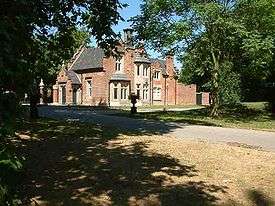
Derby Arboretum, donated to the town by local philanthropist Joseph Strutt in 1840, was the first planned urban public park in the country. Although it suffered from neglect in the 1990s, it has been renovated. It has been claimed to have been one of the inspirations for Central Park in New York.[54]
Markeaton Park is Derby's most used leisure facility.[55] Other major parks in the city include Allestree Park, Darley Park, Chaddesden Park, Alvaston Park, Normanton Park and Osmaston Park. Derby is believed to be one of the country's highest, if not the highest, ranking cities for parkland per capita. Darley and Derwent Parks lie immediately north of the city centre. Derby Rowing Club and Derwent Rowing Club are located on the banks of the river, where there is also a riverside walk and cycle path.
There are four museums: Derby Museum and Art Gallery, Pickford's House Museum, The Silk Mill and The Royal Crown Derby Museum.
Shopping and nightlife
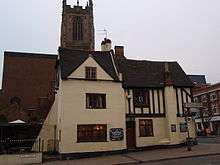
Shopping in central Derby is divided into three main areas. These are the Cathedral Quarter, the St Peters Quarter and the Intu Derby shopping centre. The Cathedral Quarter was Derby's first BID (Business Improvement District), and includes a large range of shops, boutiques, coffee shops and restaurants. It is focused around the Cathedral and the area around Irongate and Sadler Gate. It includes the Market place, the Guildhall and Assembly Rooms along with the City Museum and the Silk Mill industrial museum.
The St Peters Quarter is Derby's second Business Improvement District, brought into effect in the summer of 2011. Its boundary with the Cathedral Quarter follows Victoria Street, beneath which flows the underground course of the Markeaton Brook. The quarter boasts a diverse range of retail shops, many of them, in Green Lane, Babington Lane, Osmaston Road and elsewhere, independent traders. St Peters Street, London Road and East Street also include a large choice of national retailers and pubs, restaurants, banks and offices. The quarter includes the historic St Peters Church and, on St Peter's Churchyard, the medieval Derby School building. Nearby also is the Old Courthouse and several other notable buildings. At the eastern end of the quarter is the bus station along with the Hilton Hotel and Holiday Inn, part of the Riverlights Development on the banks of the Derwent.
Intu Derby is the city's main indoor shopping centre. It opened in 2007 as Westfield Derby after extension work costing £340 million, subsequently being sold to Intu in March 2014.[56] It contains a food court and a 12-screen cinema (Showcase – Cinema De Lux) which was opened in May 2008. The development was controversial and local opponents accuse it of drawing trade away from the older parts of the city centre where independent shops are located. Some of these experienced a downturn in trade and some have ceased trading since the development opened leading to the "Lanes" project which eventually became the second BID and the formation of St Peters Quarter. In the centre itself, a combination of high rents and rising rates have made things difficult for smaller traders.[57]
The Friar Gate area contains clubs and bars, making it the centre of Derby's nightlife. Derby is also well provided with pubs and is renowned for its large number of real ale outlets. The oldest pub is the Grade II listed Ye Olde Dolphin Inne, dating from the late 16th century.[58]
Out-of-town shopping areas include the Kingsway Retail Park, off the A38; the Wyvern Retail Park, near Pride Park; and the Meteor Centre, on Mansfield Road.
Education
Like most of the UK, Derby operates a non-selective primary and secondary education system with no middle schools. Pupils attend infant and junior school (often in a combined primary school) before moving onto a secondary school. Many of the secondary schools have sixth forms, allowing pupils to optionally take A Levels after the end of compulsory education. For those who want to stay in education but leave school, the large Derby College provides post-16 courses for school leavers, apprentices and employer-related training. It has two main campuses: the Joseph Wright Centre in the centre of Derby, where its A Level courses are based, and the historical Derby Roundhouse, the college's vocational training hub, providing a centre for apprenticeships such as engineering, catering and hair and beauty. The college also works in partnership with schools across the county to provide vocational training opportunities for students aged 14 upwards. Training for companies is undertaken through its Corporate College.
Inside the state sector, there are 15 secondary schools. These are: Allestree Woodlands School, Bemrose School, Chellaston Academy, City of Derby Academy, Da Vinci Academy, Derby Manufacturing UTC, Derby Moor Academy, Derby Pride Academy, Landau Forte College, Lees Brook Community School, Littleover Community School, Merrill Academy, Murray Park School, Noel-Baker School, Saint Benedict Catholic Voluntary Academy and West Park School.
Outside the state sector, there are three fee-paying independent schools. Derby Grammar School was founded in 1994 and was for boys only until 2007, when they accepted girls into the sixth form for the first time. They aim to continue the work and traditions of the former Derby School, which closed in 1989, one of the oldest schools in England. Derby High School is for girls-only for senior and sixth form and for girls and boys at primary level.
Derby has special needs establishments including Ivy House School at the Derby Moor Community Sports College (which takes pupils from nursery to sixth form) and the Light House which is a respite facility for children and parents. Allestree Woodlands School have a Hearing Impaired department, and Saint Benedict have an Enhanced Resource Base for pupils to access specialised support within mainstream schooling. There also a number of alternative provision schools, including Derby Pride Academy.
The University of Derby has its main campus on Kedleston Road. There is another campus in north Derbyshire at Buxton.
In 2003 the University of Nottingham opened a graduate entry medical school based at Royal Derby Hospital. The university also has its School of Nursing and Midwifery there, having moved from its former home at the London Road Community Hospital in mid-2012.
Media
The Derby Telegraph (formerly the Derby Evening Telegraph) is the city's daily newspaper. Crime writer Richard Cox set his first book around his own experience as a Derby Telegraph reporter in the 1970s.[59] The Derby Trader was a free weekly newspaper that is no longer in print. BBC Radio Derby, the BBC's local station for Derbyshire and East Staffordshire, is based on St Helen's Street in the city and offers local, national and international news, features, music and sports commentaries. It is available on 104.5 FM and 1116 AM, on 95.3 FM in north and mid-Derbyshire and on 96.0 FM in the Buxton area, as well as being streamed on the internet. The BBC in Derby have their own local website for the area providing news, travel and weather information, as well as other features.
Capital East Midlands is the biggest commercial radio station in the city, broadcasting to Derby on 102.8 FM from the transmitter at Drum Hill, just outside the city. It broadcasts a Contemporary Hit Radio (CHR) format, with Top 40 chart hits aimed at the city's under-35s.
Notable people
Arts, literature and music
- Samuel Richardson (1689–1761), writer[60] and printer[61]
- William John Coffee (1774–1846), artist and sculptor,[62] worked in porcelain, plaster, and terracotta
- Joseph Wright of Derby (1734–1797), landscape[63] and portrait painter
- John Raphael Smith (1751–1812), painter[64] and mezzotint engraver, son of Thomas Smith
- William Billingsley (1758–1828), painter of porcelain,[65] founded Nantgarw Pottery
- John Emes (1762–1810), engraver[66] and water-colour painter
- Graham Coxon (born 1969), musician and co-founder of Blur, is from the nearby Spondon
- Elizabeth Bridget Pigot (1783–1866) correspondent,[67] friend and biographic source for Lord Byron
- Henry Lark Pratt (1805–1873), painter[68] who trained in the porcelain industry
- John Haslem (1808–1884), china[69] and enamel painter
- Henry Britton (1843–1938), journalist[70] in colonial Australia
- Charles Rann Kennedy (1871–1950) Anglo-American[71] dramatist.
- Ernest Townsend (1880–1944), portrait[72] artist
- Marion Adnams (1898–1995), painter, printmaker, and draughtswoman.[73]
- Ralph Downes (1904–1993), organist,[74] designer of the organ in the Royal Festival Hall, London
- Norah, Lady Docker (1906–1983), socialite,[75] was said to be "gracelessly gaudy"
- Ronald Binge (1910–1979), composer[76] and arranger of light music
- Eric Malpass (1910–1996), novelist,[77] wrote humorous and witty descriptions of rural family life
- Denny Dennis (1913–1993), romantic vocalist[78] when British dance bands were at the peak of their popularity.
- John Dexter (1925–1990), theatre,[79] opera and film director.
- Michael Rayner (1932–2015), opera singer, baritone roles of the Savoy Operas with the D'Oyly Carte Opera Company
- Richard Turner (born 1940), also known as Turneramon, an artist and poet
- Anton Rippon (born 1944), journalist, author and publisher
- Kevin Coyne (1944–2004), musician,[80] film-maker and writer
- Stephen Marley (born 1946), author and video game designer of the Chia Black Dragon series
- Peter Hammill (born 1948), singer-songwriter and founder of rock band Van der Graaf Generator
- Stephen Layton (born 1966), choral conductor[81] founded the choir Polyphony in 1986
- Jyoti Mishra (born 1966), sole member of White Town, the name of which was meant as a reference to Derby's perceived lack of diversity[82]
- Liam Sharp (born 1968), comic book artist, writer, publisher, and co-founder/CCO of Madefire Inc.
- Duncan Lloyd (born c. 1980), guitarist and singer
- Corey Mwamba, jazz musician and BBC Radio 3 presenter[83]
- Jessica Garlick (born 1981), singer,[84] was born in Derby
- Lucy Ward (born 1989), folk musician[85] and songwriter
- Jack O'Connell (born 1990), actor
- Youngman (born c. 1990), MC[86] and vocalist
- Dubzy (born 1991), grime music MC and entrepreneur,[87] raised in Derby
- Drumsound & Bassline Smith (formed 1998), electronic group[88]
Films, TV and radio
- Ted Moult (1926–1986), farmer and TV personality
- Patricia Greene (born 1931), radio actress, long-standing role as matriarch Jill Archer in The Archers
- Alan Bates (1934–2003), actor; in 1969 he co-starred in the Ken Russell film Women in Love
- Michael Knowles, (born 1937), actor, played Capt. Jonathan Ashwood in the 1970s sitcom It Ain't Half Hot Mum
- Gwen Taylor (born 1939), actress, played Amy Pearce in the sitcom Duty Free
- Judith Hann (born 1942), presented BBC's Tomorrow's World between 1974 and 1994
- Kevin Lloyd (1949–1998), actor, played DC Alfred "Tosh" Lines in The Bill
- John Tams (born 1949), actor, singer, songwriter, composer and musician
- Stuart Varney (born 1949), economic journalist[89] for Fox News Channel
- Richard Felix (born 1949), paranormal investigator[90] from Stanley, appeared on Sky Living Most Haunted series
- Terry Lloyd (1952–2003), TV journalist[91] unlawfully killed in Iraq by US Marines
- Maxwell Caulfield (born 1959), English-American[92] film, stage, and television actor, based in the USA
- Keiran Lee (born 1984), pornographic film actor, director and producer[93] for Brazzers
- Michael Socha (born 1987), actor,[94] roles in the films This Is England and Summer
- Jack O'Connell (born 1990), actor,[95] propensity for playing angry, troubled youth
- Lauren Socha (born 1990), actor, played Kelly Bailey[96] in E4's television series Misfits
Academics, science, business and engineering
- John Flamsteed (1646–1719), astronomer,[97] the first Astronomer Royal; he catalogued over 3000 stars
- George Sorocold (c. 1668 – c. 1738), engineer and architect; designed Lombe's Mill
- John Lombe (1693–1722), silk spinner in 18th-century Derby; created Lombe's Mill
- John Whitehurst (1713–1788), clockmaker[98] and scientist; early contributions to geology, member of the Lunar Society
- William Hutton (1723–1815) historian,[99] poet and bookseller
- Jedediah Strutt (1726–1797), hosier and cotton spinner,[100] developed the production of ribbed stockings
- Erasmus Darwin (1731–1802), physician[101] and philosopher[102]
- Henry Cavendish (1731–1810), scientist,[103] experimental and theoretical chemist and physicist; discovered hydrogen
- John Mawe (1764–1829), practical mineralogist,[104] with his wife Sarah Mawe
- James Fox (1780–1830), engineer,[105] machine tool maker
- Edward Blore (1787–1879), landscape[106] and architectural artist, architect and antiquary
- William George Spencer (1790–1866) schoolmaster,[107] tutor and mathematical writer; Derby Philosophical Society
- Andrew Handyside (1806–1887), iron founder,[108] created The Handyside Postbox
- Sir Charles Fox (1810–1874), civil engineer[109] and contractor, focusing on railways, railway stations and bridges.
- Florence Nightingale (1820–1910), pioneer[110] of modern nursing
- Herbert Spencer (1820–1903), philosopher,[111] biologist, anthropologist, sociologist, and classical liberal political theorist
- Parkin Jeffcock (1829–1866), mining engineer;[112] died trying to rescue miners
- Sir William de Wiveleslie Abney KCB, FRS (1843–1920), astronomer,[113] chemist, photographer; described the Abney effect
- Sir Henry Royce (1863–1933), co-founder[114] of Rolls-Royce
- Gordon Pask (1928–1996), author, inventor,[115] educational theorist, cybernetician and psychologist
- Sir Nigel Rudd (born 1946), industrialist;[116] founded Williams Holdings
- Prof John Loughhead OBE FREng FIMechE FIET (born 1948), businessman,[117] Chief Scientific Adviser to BEIS
- John Smith (born 1957), the Chief Executive Officer[118] of BBC Worldwide
- Melvyn Morris CBE (born c. 1957) businessman;[119] owns Derby County F.C., made his money from Candy Crush Saga
- Karl Slym (1962–2014) businessman,[120] managing director of Tata Motors 2012–2014
Politics, religion and law
- Joan Waste (1534–1556), a blind woman[121] who was burned in Derby for refusing to renounce her Protestant faith
- John Cotton (1585–1652), English and American Puritan divine,[122] sometimes called "The Patriarch of New England"
- Samuel Bourn the Elder (1648–1719), dissenting minister;[123] his theology was Calvinistic
- Thomas Bott (1688–1754); cleric[124] of the Church of England, known as a controversialist
- Daniel Coke (1745–1825), barrister[125] and MP for Derby 1776–1780 and Nottingham 1780–1812
- Alleyne FitzHerbert, 1st Baron St Helens (1753–1839), diplomat,[126] eponym of Mount St. Helens
- Sir Charles John Crompton (1797–1865), justice[127] of the queen's bench
- William Mundy (1801–1877), son of Francis Mundy, MP[128] for South Derbyshire and High Sheriff of Derbyshire in 1844
- Samuel Plimsoll (1825–98), politician,[129] Liberal MP for Derby, inventor of the Plimsoll line, 'The Sailor's Friend'
- Sir Henry Wilmot (1831–1901), Victoria Cross recipient,[130] MP for South Derbyshire 1869–1885
- Robert Humpston VC (1832–1884), recipient[131] of the Victoria Cross for gallantry during the Crimean War
- Walter Weston (1860–1940), clergyman[132] and Anglican missionary, popularized mountaineering in Japan
- Alice Wheeldon (1866–1919), pacifist[133] and anti-war campaigner.
- Jacob Rivers VC (1881–1915), recipient of the Victoria Cross for action in World War I
- Alfred Waterson (1880–1964), Labour and Co-operative MP[134] for Kettering 1918–1922
- Brigadier Charles Hudson VC, CB, DSO & Bar, MC (1892–1959), British Army Victoria Cross recipient
- Freda Bedi (1911–1977), social worker,[135] writer and Gelongma, ordained in Tibetan Buddhism
- Geoffrey Lane, Baron Lane AFC, PC, QC (1918–2005), judge[136] who served as Lord Chief Justice 1980–1992
- Chris Moncrieff CBE (1931–2019), parliamentary journalist,[137] political editor of the Press Association 1980–1994
- Dame Margaret Beckett DBE MP (born 1943), Labour Party politician, MP for Derby South since 1983
- Dafydd Wigley (born 1943), Plaid Cymru MP[138] for Caernarfon 1974–2001
- Bob Laxton (born 1944), Labour Party politician,[139] MP for Derby North 1997–2010
- Geoff Hoon (born 1953), Labour politician,[140] MP for Ashfield 1992–2010
- Helen Clark (born 1954), politician,[141] Labour MP for Peterborough 1997–2005
- Chris Williamson (born 1956), Labour politician, MP for Derby North 2010–2015 and 2017–2019
Sports
- Tom Johnson (c. 1750–1797), bare-knuckle fighter
- Steve Bloomer (1874–1938), footballer[142] and manager, played for Derby County and Middlesbrough FC, 598 pro appearances
- Charlie Hudson (1874–1958), pigeon racer,[143] winner of the Rome–England champion race in 1913 with The King of Rome
- Reg Parnell (1911–1964), racing driver[144] and team manager
- Louis Martin (1936–2015), weightlifter, Olympic silver medallist, 1964
- Mark Robinson (born 1963), PDC darts player
- Sir Dave Brailsford (born 1964), cycling administrator,[145] currently with Team Ineos
- Max Sciandri (born 1967), professional cyclist[146] and Olympic medallist
- Rufus Brevett (born 1969), footballer[147] with nearly 500 professional appearances
- Steve Holland (born 1970), former professional footballer, coach for Crewe Alexandra and Chelsea
- Colin Osborne (born 1975), PDC darts player[148]
- Donna Kellogg MBE (born 1978) badminton player,[149] competed in the 2004 and 2008 Summer Olympics
- Chris Riggott (born 1980), footballer,[150] over 200 pro appearances
- Bobby Hassell (born 1980), footballer,[151] over 380 pro appearances
- Damien Walters (born 1982), stuntman,[152] gymnast and free runner
- Chris Palmer (born 1983), footballer,[153] over 230 pro appearances
- Hemish Ilangaratne (born 1987), cricketer
- Melissa Reid (born 1987), golfer[154]
- Jonathan Joseph (born 1991), England international professional rugby union player
- Jamaal Lascelles (born 1993) footballer,[155] captain of Newcastle United F.C.
- Sarah Vasey (born 1996), swimmer, 50 metre breaststroke gold medallist[156] at the 2018 Commonwealth Games.
International relations
Twin towns
Derby is twinned with Osnabrück in Germany. The partnership treaty between the two cities was signed on 17 February 1976.[157]
The twinning agreement with Derby was in the historical Hall of Peace in Osnabrück's Rathaus (town hall). Every year, Derby and Osnabrück each appoint an envoy who spends twelve months in the twin city. The envoy promotes the exchange of ideas between the two cities and acts as an educational and information officer to increase awareness of the twinning scheme. The envoy gives talks to local societies and schools, finds pen friends and short-term host families during work placements, works to assist groups who want to get involved in twinning by identifying and approaching possible counterparts and plans the annual May Week trip.
There is an annual exchange between the wind bands of John Port School, Etwall, and its twin school Gymnasium Melle in Melle, Germany, District of Osnabrücker Land. An exchange was established in 2009 between Allestree Woodlands School and the Gymnasium Angelaschule in Osnabrück. This exchange was originally based on a drama project by both schools in June 2009, which included performances in both cities with over 1600 visitors. It is now a language and culture exchange between the two schools, run by the German department at Allestree Woodlands School.
The exchange of envoys between two cities is very unusual. The envoy in Osnabrück changes every year and Osnabrück also sends envoys to Derby, Angers and Çanakkale. No other city in Germany participates in this exchange of envoys, and in Britain, only one other town, Wigan, receives and sends an envoy.
In 2014, Derby became a sister-city with the Palestinian city of Hebron.[158]
List of twin towns







Freedom of the City
The following people and military units have received the Freedom of the City of Derby.
Individuals
- Adam George Peaty MBE: 9 October 2016.[159]
- Reginald Frederick Harrison: 5 February 2019.[160][161]
Military units
- The Royal Naval Submarine Service: 28 April 2002.
Notes
- Matlock is generally considered the county town since the relocation of the Derbyshire County Council headquarters there in 1956.
References
- British Urban Pattern: Population Data (Epson) Archived 24 September 2015 at the Wayback Machine
- "Resident Population Estimates by Ethnic Group (Percentages)". Office for National Statistics. Archived from the original on 28 September 2013. Retrieved 23 July 2010.
- "Derby Cathedral". You & Yesterday. Archived from the original on 12 May 2008. Retrieved 4 February 2008.
- Walker, Ian W (2000). Mercia and the Making of England Sutton ISBN 0-7509-2131-5.
- Ekwall, Eilert (1960) [1936]. The Concise Oxford Dictionary of English Place Names (Fourth ed.). Oxford: Clarendon Press. p. 143. ISBN 0-19-869103-3.
- "Map of Derbyshire". British Library Prints. Archived from the original on 13 April 2019. Retrieved 12 February 2019.
- The Rivers of Time Ron McKeown, ISBN 0-9530603-7-3
- "W.G. and J. Strutt Ltd., of Belper, Derbyshire, cotton spinners". Archived from the original on 29 June 2015. Retrieved 27 June 2015.
- Archived 17 October 2007 at the Wayback Machine, Derby District: Total Population
- "About Cromford Mill". Archived from the original on 20 May 2013. Retrieved 26 December 2012.
- "Cromford Mills – birthplace of the industrial revolution". Archived from the original on 24 January 2016. Retrieved 26 December 2012.
- "The 1st water powered Cotton Spinning Mill in the World". Archived from the original on 24 January 2016. Retrieved 26 December 2012.
- Funding the vision – Henry Hunt Hutchinson and his will http://blogs.lse.ac.uk/lsehistory/2015/09/30/funding-the-vision-henry-hunt-hutchinson-and-his-will/ Archived 29 June 2017 at the Wayback Machine
- "Nothing ever happens in Sinfin". This is Sinfin. Archived from the original on 11 August 2013. Retrieved 8 November 2014.
- "Archived copy". Archived from the original on 28 February 2007. Retrieved 6 October 2006.CS1 maint: archived copy as title (link)
- "DADARS: Detailed History 1911 to 1961". www.dadars.org.uk. Derby & District Amateur Radio Society. Archived from the original on 5 March 2016. Retrieved 4 February 2017.
- "Derby Wireless Club". www.derbywirelessclub.org.uk. Derby Wireless Club. Archived from the original on 5 February 2017. Retrieved 4 February 2017.
- "BBC – World War One At Home, Midland Railway Works, Derby: The Night Lights Were Left On". BBC. Archived from the original on 20 July 2015. Retrieved 27 June 2015.
- "Facts and Statistics". www.derby.anglican.org. Diocese of Derby. Archived from the original on 5 February 2017. Retrieved 4 February 2017.
- Lambert, Tim. "A brief history of Derby, Derbyshire, England". The History of the World. Archived from the original on 9 August 2011. Retrieved 11 August 2011.
- "No. 47246". The London Gazette. 14 June 1977. p. 7656.
- The Times. 29 July 1977
- Kirk, Felix & Bartnik, 2002
- "Stories". Youandyesterday.co.uk. 27 July 1942. Archived from the original on 7 August 2008. Retrieved 17 July 2010.
- "Council Meeting 23 July 2014". derby.gov.uk. 23 July 2014. Retrieved 12 February 2019.
- "Derby City Council Ward Boundaries". data.gov.uk. 10 December 2013. Archived from the original on 12 February 2019. Retrieved 12 February 2019.
- "City Centre Conservation Area" (pdf). Derby City Council. Derby City Council. Archived from the original on 3 November 2018. Retrieved 21 August 2018.
- "Landscape Character". Derbyshire County Council. 2013. Archived from the original on 23 September 2015. Retrieved 17 August 2015.
- "Derby climate: Average Temperature, weather by month, Derby weather averages - Climate-Data.org". en.climate-data.org. Archived from the original on 27 October 2018. Retrieved 27 October 2018.
- "Climate Derby". Climate-Data.org. Archived from the original on 29 June 2019. Retrieved 6 June 2019.
- "Derbyshire's Top 200 businesses unveiled by University of Derby and Derby Telegraph". www.derby.ac.uk. Retrieved 15 June 2019.
- "Derby Power Station and Old Silk Mill Pub". Europeana. Retrieved 4 August 2020.
- "Derby Nostalgia – Derby Nostalgia Photos, Derby Archives – Derby Telegraph". Derby Telegraph. Archived from the original on 1 October 2010. Retrieved 21 May 2010.
- "Infinity Park Derby: Official start to £200m business park vital to city's future". Derby Telegraph. 5 December 2014. Archived from the original on 24 March 2015. Retrieved 11 March 2015.
- "Derby Cathedral Peregrine Project". Derby City Council. Archived from the original on 22 April 2012. Retrieved 11 August 2011.
- "Derby Peregrine Webcam". Derby City Council. Archived from the original on 1 December 2017. Retrieved 30 November 2017.
- "Neville test-drives city's new ring road". Archived from the original on 11 September 2012. Retrieved 17 March 2011.
- "Orchestra moves to Cathedral Quarter". Derby Telegraph. 23 August 2014. Archived from the original on 24 September 2015. Retrieved 24 January 2017.
- "Summer Organ Recitals". Archived from the original on 16 September 2016. Retrieved 15 August 2016.
- Johnson, Robin (18 July 2018). "Look what Derby's historic former Grand Theatre is set to become". Derby Telegraph. Retrieved 10 August 2020.
- "OddSocks". Archived from the original on 31 July 2016. Retrieved 15 August 2016.
- "Déda – Derby – Dance-Focussed Arts". www.deda.uk.com. Archived from the original on 28 March 2018. Retrieved 28 March 2018.
- "Home – Derby Book Festival". Derby Book Festival. Archived from the original on 25 March 2018. Retrieved 28 March 2018.
- "Derby Feste – Derby Festé 2018 will arrive on 27 to 29 September, transforming Derby into a playground with performances for everyone". Archived from the original on 13 February 2019. Retrieved 12 February 2019.
- "Six Streets Arts Trail". Archived from the original on 20 August 2014. Retrieved 15 October 2014.
- "sixstreetsderby.org.uk". www.sixstreetsderby.org.uk. Archived from the original on 4 September 2017. Retrieved 28 March 2018.
- http://www.derbytelegraph.co.uk/Bygones-New-Derby-Theatre-production-marks-60th/story-28824072-detail/story.html%5B%5D
- "The History of Derby County Football Club". Derby County Football Club. 8 May 2011. Archived from the original on 28 December 2011. Retrieved 11 August 2011.
- Flanagan, Chris (13 November 2017). "Derby County's shocking 2007/08 revisited: the Premier League's worst ever season, told by those who were there". Four Four Two. Retrieved 20 July 2020.
- Profile on Ladies European Tour's official site Archived 27 December 2011 at the Wayback Machine
- "Derby Olympian Arthur Keily picks up lifetime achievement gong". This is Derbyshire. Northcliffe Media. 20 September 2008. Archived from the original on 13 September 2012. Retrieved 14 August 2011.
- "keily, Arthur". bygonederbyshire. Retrieved 26 May 2009.
- "Arboretum history". Christopher Harris. 2010. Archived from the original on 10 August 2011. Retrieved 16 August 2011.
- "Markeaton Park – today". BBC. October 2002. Archived from the original on 21 March 2012. Retrieved 14 August 2011.
- Johnson, Robin (20 March 2014). "Westfield Derby shopping centre sold to Intu for £390m". Derby Evening Telegraph. Archived from the original on 14 July 2014. Retrieved 4 July 2014.
- "Westfield Derby – About". westfieldderby.co.uk. Archived from the original on 10 April 2008. Retrieved 4 February 2008.
- Historic England. "Ye Olde Dolphin Inne, Derby (1228932)". National Heritage List for England. Retrieved 18 August 2014.
- Paul Linford (10 June 2014). "Former reporter tells tale of violence and corruption". HoldTheFrontPage.co.uk. Archived from the original on 21 December 2014. Retrieved 29 June 2014.
- . Encyclopædia Britannica. 23 (11th ed.). 1911.
- . Dictionary of National Biography. 48. 1896.
- Derbyshire Heritage Artists, artsderbyshire.org.uk Archived 1 March 2018 at the Wayback Machine retrieved 28 February 2018
- . Encyclopædia Britannica. 28 (11th ed.). 1911.
- . Dictionary of National Biography. 53. 1898.
- Victoria & Albert Museum, Collections, Billingsley, William Archived 1 March 2018 at the Wayback Machine retrieved 28 February 2018
- . Dictionary of National Biography. 17. 1889.
- . Dictionary of National Biography. 45. 1896.
- BBC Stoke and Staffordshire, 24 September 2014, Visual Arts, Paintings from Newcastle Museum Archived 27 January 2019 at the Wayback Machine retrieved 28 February 2018
- . Dictionary of National Biography. 25. 1891.
- Mennell, Philip (1892). . The Dictionary of Australasian Biography. London: Hutchinson & Co – via Wikisource.
- . Encyclopedia Americana. 1920.
- Arts Derbyshire, Derbyshire Heritage, visual artists Archived 1 March 2018 at the Wayback Machine retrieved 3 March 2018
- Seddon, Peter (2011). "'Derbyshire's Dali' A Surreal One-Off". Derbyshire Life Magazine: 246–248.
- The Independent, 1 January 1994, Obituary: Marc Naylor Archived 28 February 2018 at the Wayback Machine retrieved 27 February 2018
- The Free Library.com, Castle's owners lived life to excess Archived 2 March 2018 at the Wayback Machine retrieved 28 February 2018
- Biography at the Robert Farnon Society Archived 20 April 2018 at the Wayback Machine retrieved 27 February 2018
- IMDb Database Archived 27 December 2018 at the Wayback Machine retrieved 27 February 2018
- Independent, 4 November 1993, Obituary: Denny Dennis Archived 28 February 2018 at the Wayback Machine retrieved 27 February 2018
- IMDb Database Archived 16 February 2017 at the Wayback Machine retrieved 27 February 2018
- The Guardian, 6 Dec 2004, Obituary, Kevin Coyne Archived 13 January 2018 at the Wayback Machine retrieved 27 February 2018
- Greenfield, Edward (10 September 2004). "Tavener: Schuon Hymnen; The Second Coming; Shunya; Butterfly Dreams; Birthday Sleep etc: Polyphony/Layton". The Guardian. Retrieved 20 July 2020.
- Dazed (8 February 2017). "Remembering one of the UK's unlikeliest number one singles". Dazed. Retrieved 10 January 2020.
- "Archived copy". Archived from the original on 7 November 2019. Retrieved 7 November 2019.CS1 maint: archived copy as title (link)
- BBC News, 3 March 2002, Idol singer picked for Eurovision Archived 16 June 2004 at the Wayback Machine retrieved 27 February 2018
- The Guardian, 16 June 2011, Folk music, Lucy Ward: Adelphi Has to Fly Archived 7 November 2017 at the Wayback Machine retrieved 27 February 2018
- The Guardian, 30 Nov 2011, New Band of the week, Youngman Archived 28 February 2018 at the Wayback Machine retrieved 27 February 2018
- BBC Music, Hear me, featuring Eyez, Manga, Dubzy, Kobi Onyame, Rukus & Kobi Onyame Archived 21 September 2018 at the Wayback Machine retrieved 27 February 2018
- Drumsound & Bassline Smith discography at Discogs Archived 28 February 2018 at the Wayback Machine retrieved 27 February 2018
- Appearances on C-SPAN Archived 28 February 2018 at the Wayback Machine retrieved 27 February 2018
- IMDb Database Archived 16 February 2017 at the Wayback Machine retrieved 27 February 2018
- The Guardian, 24 Mar 2003, Obituary: Terry Lloyd Archived 1 March 2018 at the Wayback Machine retrieved 28 February 2018
- IMDb Database Archived 14 August 2018 at the Wayback Machine retrieved 27 February 2018
- IMDb Database Archived 23 February 2018 at the Wayback Machine retrieved 8 June 2018
- IMDb Database Archived 16 April 2018 at the Wayback Machine retrieved 27 February 2018
- IMDb Database Archived 12 October 2018 at the Wayback Machine retrieved 27 February 2018
- IMDb Database Archived 24 December 2018 at the Wayback Machine retrieved 27 February 2018
- . Encyclopædia Britannica. 10 (11th ed.). 1911.
- . Dictionary of National Biography. 61. 1900.
- . Dictionary of National Biography. 28. 1891.
- . Encyclopædia Britannica. 25 (11th ed.). 1911.
- . Encyclopædia Britannica. 07 (11th ed.). 1911.
- . Dictionary of National Biography. 14. 1888.
- . Encyclopædia Britannica. 05 (11th ed.). 1911.
- . Dictionary of National Biography. 37. 1894.
- Graces Guide to British Industrial History, Fox of Derby Archived 1 March 2018 at the Wayback Machine retrieved 28 February 2018
- . Dictionary of National Biography. 05. 1886.
- . Dictionary of National Biography. 53. 1898.
- BBC, History of the World, The Handyside Postbox Archived 5 February 2016 at the Wayback Machine retrieved 28 February 2018
- . Dictionary of National Biography. 20. 1889.
- . Encyclopædia Britannica. 19 (11th ed.). 1911.
- . Dictionary of National Biography (2nd supplement). 1912.
- . Dictionary of National Biography. 29. 1892.
- The University of Derby's Online Journal, Archive, The Firs.. retrieved 28 February 2018
- Flight article, 5 October 1956, Sir Henry Royce, Bart Archived 1 March 2018 at the Wayback Machine retrieved 28 February 2018
- International Federation for Systems Research, July 1, 1994, Gordon Pask Archived 28 October 2017 at the Wayback Machine retrieved 28 February 2018
- Loughborough University profile, Sir Nigel Rudd Archived 3 March 2016 at the Wayback Machine retrieved 28 February 2018
- GOV.UK, Press Release, 2 Oct 2014, DECC appoints new chief scientific advisor Archived 13 February 2018 at the Wayback Machine retrieved 28 February 2018
- Management Today, The MT Interview: BBC Worldwide's John Smith Archived 4 March 2018 at the Wayback Machine retrieved 28 February 2018
- Blomberg, Company Overview of Derby County Football Club Ltd Archived 3 March 2018 at the Wayback Machine retrieved 28 February 2018
- Telegraph, 26 Jan 2014, Tata Motors boss Karl Slym dies..... Archived 4 March 2018 at the Wayback Machine retrieved 28 February 2018
- Derby City Council, 10 February 2017, Blue Plaque......Joan Wast Archived 16 May 2017 at the Wayback Machine retrieved 28 February 2018
- . Encyclopædia Britannica. 07 (11th ed.). 1911.
- . Dictionary of National Biography. 06. 1886.
- . Dictionary of National Biography. 05. 1886.
- . Dictionary of National Biography. 11. 1887.
- . Dictionary of National Biography. 19. 1889.
- . Dictionary of National Biography. 13. 1888.
- HANSARD 1803–2005 → People (M), Mr William Mundy Archived 5 March 2016 at the Wayback Machine retrieved 28 February 2018
- . Dictionary of National Biography (1st supplement). 1901.
- Hansard 1803–2005, contributions by Sir Henry Wilmot Archived 1 March 2018 at the Wayback Machine retrieved 28 February 2018
- BBC NEWS CHANNEL, 8 September 2007, Crimean soldier's grave dedicated Archived 23 December 2018 at the Wayback Machine retrieved 28 February 2018
- Cambridge Alumni Database, University of Cambridge, Weston, Walter (WSTN880W) retrieved 3 March 2018
- BBC News Online, 19 January 2012, Fight to clear.... Archived 23 December 2018 at the Wayback Machine retrieved 28 February 2018
- HANSARD 1803–2005 → People (W), Mr Alfred Waterson Archived 22 June 2017 at the Wayback Machine retrieved 3 March 2018
- Oxford Today, 31 May 2017, From Oxford to Lahore.... Archived 15 April 2019 at the Wayback Machine retrieved 27 February 2018
- The Guardian, 23 Aug 2005, Obituary, Lord Lane of St Ippollitts Archived 30 October 2017 at the Wayback Machine retrieved 28 February 2018
- Independent, 29 October 2007, Chris Moncrieff: So good..... Archived 4 March 2018 at the Wayback Machine retrieved 28 February 2018
- Hansard 1803–2005, contributions by Dafydd Wigley Archived 20 January 2018 at the Wayback Machine retrieved 28 February 2018
- TheyWorkForYou, Bob Laxton, Former MP, Derby North Archived 3 March 2018 at the Wayback Machine retrieved 28 February 2018
- TheyWorkForYou, Geoff Hoon, Former MP, Ashfield Archived 1 March 2018 at the Wayback Machine retrieved 28 February 2018
- Ms Helen Clark, Former MP, Peterborough, Theyworkforyou Archived 1 March 2018 at the Wayback Machine retrieved 28 February 2018
- Derby City Council, 16 February 2018, Blue Plaque unveiled for football legend, Steve Bloomer Archived 18 February 2018 at the Wayback Machine retrieved 26 February 2018
- "The King of Rome Charlie Hudson". Archived from the original on 4 June 2011. Retrieved 21 January 2018.
- Reg Parnell, Oldracingcars.com Archived 27 February 2018 at the Wayback Machine retrieved 26 February 2018
- Sir Dave Brailsford, Team Sky Archived 27 February 2018 at the Wayback Machine retrieved 26 February 2018
- Max Sciandri, Cycling Archives Archived 27 February 2018 at the Wayback Machine retrieved 26 February 2018
- SoccerBase Database Archived 27 February 2018 at the Wayback Machine retrieved 26 February 2018
- Player profile, Colin Osborne, Dartsdatabase Archived 30 June 2017 at the Wayback Machine retrieved 26 February 2018
- Donna Kellogg at BadmintonEngland.co.uk retrieved 26 February 2018
- SoccerBase Database Archived 27 February 2018 at the Wayback Machine retrieved 26 February 2018
- SoccerBase Database Archived 27 February 2018 at the Wayback Machine retrieved 26 February 2018
- IMDb Database Archived 31 May 2019 at the Wayback Machine retrieved 26 February 2018
- SoccerBase Database Archived 27 February 2018 at the Wayback Machine retrieved 26 February 2018
- Melissa Reid, Ladies European Tour, official site Archived 30 October 2017 at the Wayback Machine retrieved 26 February 2018
- SoccerBase Database Archived 5 October 2018 at the Wayback Machine retrieved 3 March 2018
- "Commonwealth Games: Sarah Vasey and Alice Tai win gold for England". BBC Sport. 6 April 2018. Archived from the original on 24 October 2018. Retrieved 24 August 2018.
- Derby City Council. "Town twinning". Archived from the original on 3 August 2014. Retrieved 20 August 2014.
- "History made as Derby becomes 'sister city' of Hebron, Palestine". Derby Telegraph. Archived from the original on 23 September 2015.
- "Adam Peaty awarded Freedom of the City". Derby Arena. 10 October 2016. Retrieved 20 July 2020.
- "Reg Harrison receives Freedom of the City". Derby County F.C. 6 February 2019. Retrieved 20 July 2020.
- https://www.facebook.com/DerbyCountyOfficial/videos/538882996520643/
Bibliography
External links
| Wikimedia Commons has media related to Derby. |
- Chisholm, Hugh, ed. (1911). . Encyclopædia Britannica. 08 (11th ed.). Cambridge University Press.
| Wikivoyage has a travel guide for Derby. |
